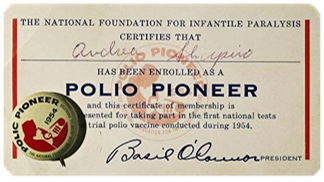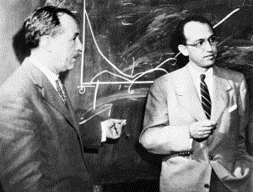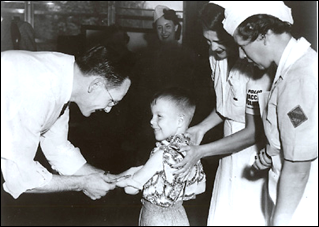Polio Cases During the 1954 Salk Vaccine Trial
Polio Pioneer card given to each child along with a piece of candy, 1954.
The 1954 trial of the polio vaccine developed by Jonas Salk is famous for having demonstrated that the vaccine was both safe and effective in providing protection against polio. What is less well known is that children did develop polio during the trial. According to Charlotte Jacobs, author of Jonas Salk: A Life, there were 749,000 children who participated in the areas conducted with a vaccine and a placebo. Thirty-three children who had been vaccinated developed polio, as did 110 children who received the placebo. Among the 725,000 children who received either the vaccine or served as an unvaccinated control group, there were 38 cases of polio in those vaccinated and 331 cases in the unvaccinated controls. Paul Offit in his book The Cutter Incident noted that 16 children died of polio while in the trial, but none of them had been vaccinated with the Salk vaccine.
Dr. Thomas Francis with Jonas Salk, 1955.
Dr. Thomas Francis (University of Michigan), who conducted the trial and analyzed the results, estimated the Salk vaccine o be 60-70% effective against Type I polio and 90% effective against Types II and III. Because the Salk vaccine was not 100% effective, some children who were vaccinated could and did develop polio, although none of their cases were fatal.
Thus, during the 1954 polio season when the Salk trial was conducted, three kinds of children developed polio: Seventy-one children who had received the Salk vaccine developed polio; 441 children who participated in the trial but received a placebo or served as an unvaccinated control came down with polio; and nationally among individuals who did not participate in the trial 18,308 individuals developed paralytic polio and 20,168 developed non-paralytic polio (for a total of 38,476 cases). With the introduction of the Salk vaccine nationally in 1955 the number of annual polio cases began to decline dramatically to 15,000 in 1956 and 3,190 in 1960.
Randall Kerr gets the first shot, Franklin Sherman Elementary School, Fairfax, Virginia, April 26, 1954 (Courtesy of March of Dimes)
The Salk vaccine, like all medicine or vaccines, was never 100% effective. That meant that every year a small number of individuals developed polio despite having been vaccinated. But for the vast majority vaccinated during the 1954 trial and in subsequent years, the Salk vaccine provided the protection against polio that the nation had long sought.
“Chief objective: To determine whether a . . . Poliomyelitis vaccine would afford protection against naturally occurring paralytic Poliomyelitis in selected groups of children . . . And if protection is provided, the degree of such protection.”
- Evaluation of the 1954 Field Trial of Poliomyelitis Vaccine: Final Report, 1957



